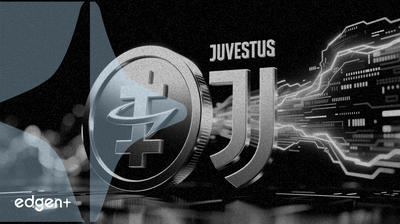Atrás


## Resumen Ejecutivo Tether, el operador de la stablecoin **USDT**, ha presentado una propuesta totalmente en efectivo para adquirir la participación controladora del 65,4% de **Exor** en el club de fútbol italiano **Juventus FC**. La oferta se combina con el compromiso de inyectar mil millones de dólares adicionales en el club una vez completada la transacción. Este movimiento representa un impulso estratégico significativo por parte de una importante entidad cripto-nativa hacia el mundo de los deportes tradicionales, con el objetivo de aprovechar sus sustanciales reservas de capital para adquirir una marca reconocida mundialmente y estabilizar su situación financiera. ## El Evento en Detalle La propuesta describe una estrategia financiera de dos vertientes. Primero, una adquisición totalmente en efectivo de la participación mayoritaria de **Exor** transferiría el control del club a **Tether**. Segundo, una inyección de capital posterior de mil millones de dólares se destina a liquidar las deudas existentes y a invertir en la capacidad operativa y competitiva del club. La transacción, si tiene éxito, marcaría una de las intersecciones de más alto perfil de la industria de activos digitales y las instituciones tradicionales, potencialmente excluyendo a la Juventus de la bolsa y llevándola a la propiedad privada bajo el gigante cripto. ## Mecanismos Financieros y Contexto Estratégico Los clubes de fútbol europeos a menudo se caracterizan por cargas de deuda sustanciales. El **Manchester United** (NYSE: MANU), por ejemplo, informó recientemente que su deuda neta superó los mil millones de dólares después de una compra apalancada. Otros clubes han buscado estructuras de financiación complejas para gestionar sus pasivos. El **AC Milan** solicitó recientemente un préstamo holdco de crédito privado de aproximadamente 600-700 millones de dólares para refinanciar la deuda en poder de su propietario anterior, Elliott Investment Management, utilizando instrumentos con opciones de pago en especie (PIK). En este contexto, la oferta totalmente en efectivo de **Tether** presenta un enfoque marcadamente diferente. En lugar de apalancar el activo para financiar su propia compra, **Tether** tiene como objetivo utilizar su capital existente para desapalancar completamente el club. Esta estrategia se parece menos a las compras apalancadas comunes en los deportes y más a una adquisición estratégica por parte de una corporación privada con mucho efectivo, como la reciente adquisición totalmente en efectivo de 36 mil millones de dólares de **Kellanova** por parte de **Mars, Incorporated**. El movimiento proporcionaría a la **Juventus** un balance limpio, una ventaja competitiva significativa en una industria intensiva en capital. ## Implicaciones para el Mercado Más Amplio Una adquisición exitosa serviría como una validación importante para **Tether** y el ecosistema de criptomonedas más amplio. Para **Tether**, representa una diversificación estratégica, desplegando sus vastas reservas en un activo no digital de alto perfil. Esto podría mejorar su legitimidad y demostrar una visión a largo plazo más allá de los confines de los mercados de criptomonedas. El acuerdo también podría establecer un nuevo modelo para las firmas cripto-nativas, demostrando que las ganancias generadas en el espacio de activos digitales pueden implementarse eficazmente para adquirir y revitalizar grandes marcas en el mundo físico. Tal movimiento señala una maduración de la industria desde el comercio especulativo hasta las finanzas corporativas estratégicas, alentando potencialmente a otras firmas cripto a buscar adquisiciones similares de activos heredados en deportes, medios de comunicación y otros sectores. ## Comentarios de Expertos y Precedentes Los observadores del mercado señalan que la adquisición propuesta enfrentará un intenso escrutinio regulatorio, similar a cualquier transacción importante de fusiones y adquisiciones transfronterizas. La aprobación incondicional del acuerdo **Mars-Kellanova** por 28 organismos reguladores en todo el mundo proporciona un precedente reciente para las complejidades involucradas. Los reguladores probablemente se centrarán en la fuente de los fondos y la estabilidad a largo plazo de la entidad adquirente. Si bien el acuerdo es poco convencional, existe un apetito demostrado de los inversores por empresas de alto perfil y transformadoras, como se ve en la anticipación del mercado por una posible IPO de **SpaceX**. Los analistas sugieren que **Tether** está proporcionando el "filete" —una inyección sustancial de efectivo— para el "sizzle" de una marca de fútbol de renombre mundial. El éxito de esta oferta no solo alteraría el panorama financiero del fútbol europeo, sino que también redefiniría los límites entre las economías digital y tradicional.

## Resumen ejecutivo Ripple está expandiendo estratégicamente la utilidad de su activo digital nativo, **XRP**, al hacerlo disponible en las blockchains de **Ethereum** y **Solana**. Esta iniciativa está diseñada para integrar **XRP** en el ecosistema más amplio de las Finanzas Descentralizadas (DeFi), yendo más allá de su caso de uso tradicional en pagos transfronterizos. La expansión aprovecha la tecnología de puentes para crear versiones envueltas de **XRP**, permitiéndole interactuar con contratos inteligentes y aplicaciones en estas plataformas DeFi líderes. ## El evento en detalle El lanzamiento de **XRP** en **Ethereum** y **Solana** se facilita a través de puentes entre cadenas, siendo **Hex Trust** y **LayerZero** identificados como socios tecnológicos clave. Este mecanismo implica bloquear el **XRP** nativo en su propio libro mayor y emitir un token **XRP** "envuelto" (wXRP) equivalente en la blockchain de destino. Este token envuelto está totalmente garantizado por el activo nativo, asegurando la paridad de precios. Este enfoque técnico permite a **XRP** adquirir las funcionalidades de un token ERC-20 en **Ethereum** o un token SPL en **Solana**. Como resultado, los titulares pueden utilizar su **XRP** en una amplia gama de aplicaciones DeFi, incluidos intercambios descentralizados (DEX) como Uniswap o Serum, protocolos de préstamo como Aave y Compound, y varias plataformas de cultivo de rendimiento nativas de estos ecosistemas. ## Implicaciones del mercado Esta expansión tiene el potencial de aumentar significativamente la liquidez y el volumen de operaciones de **XRP** al aprovechar los profundos pools de liquidez de los mercados DeFi de **Ethereum** y **Solana**. Para los traders y desarrolladores en estas plataformas, introduce un nuevo activo altamente líquido para pares de operaciones, colateralización y otras estrategias financieras. Sin embargo, la medida también introduce competencia para los activos existentes dentro de estos ecosistemas. El éxito de **XRP** envuelto dependerá de su tasa de adopción por parte de los protocolos DeFi y la voluntad de los usuarios de tender un puente entre sus activos. La implicación principal es la transformación de **XRP** de un activo centrado en pagos a un instrumento más versátil para servicios financieros descentralizados, lo que podría aumentar su utilidad y demanda generales. ## Comentario de expertos El giro estratégico hacia una utilidad más amplia se alinea con los recientes logros regulatorios de Ripple. Tras la aprobación condicional de la Oficina del Contralor de la Moneda (OCC) para una licencia bancaria fiduciaria nacional, el CEO de Ripple, **Brad Garlinghouse**, enfatizó el enfoque de la compañía en el cumplimiento y la innovación. En una declaración sobre la decisión de la OCC, señaló que fue un "paso masivo" para la industria, destacando el compromiso de operar bajo supervisión federal. Los analistas de mercado han visto favorablemente estos desarrollos paralelos. Un experto, conocido como 'Steph is Crypto', describió la inminente aprobación de la licencia bancaria como un catalizador "alcista" para **XRP**, un sentimiento compartido por otros en la comunidad financiera que ven la claridad regulatoria como un precursor de la adopción institucional. ## Contexto más amplio La estrategia multi-cadena de Ripple y su búsqueda de una licencia bancaria fiduciaria nacional son componentes interconectados de un objetivo más amplio: integrar **XRP** y los servicios relacionados dentro del sistema financiero regulado. Al obtener una licencia federal, Ripple puede ofrecer servicios de custodia y liquidación para activos digitales y tradicionales bajo la supervisión federal directa. Este estado es crucial para atraer a clientes institucionales que requieren contrapartes reguladas. La aprobación también allana el camino para la integración de la stablecoin planificada por Ripple, **RLUSD**, en el sistema bancario de EE. UU. Un fallo reciente de la OCC que permite a los bancos nacionales usar activos digitales para la liquidación fortalece aún más esta posición. Este enfoque de doble vía, expandirse a los ecosistemas descentralizados mientras se asegura simultáneamente un punto de apoyo en las finanzas tradicionales, posiciona a Ripple para cerrar la brecha entre ambos, un objetivo estratégico compartido por otros actores importantes como **Circle** y **Paxos**, que también recibieron la aprobación condicional de la OCC.

## Resumen Ejecutivo Interactive Brokers ha anunciado que ahora aceptará stablecoins para la financiación de cuentas de inversores minoristas. Esta decisión representa un movimiento estratégico para mantener la competitividad a medida que la industria de servicios financieros integra cada vez más activos digitales. La función se introducirá a través de un despliegue gradual, comenzando con una parte de la base de clientes estadounidenses elegibles de la firma. La iniciativa señala un paso significativo para cerrar la brecha entre los mercados financieros tradicionales y el ecosistema de las monedas digitales. ## El Evento en Detalle Según el anuncio, los inversores minoristas de **Interactive Brokers** tendrán la capacidad de depositar stablecoins directamente en sus cuentas de trading. Esta iniciativa está diseñada para mejorar la eficiencia y la velocidad de la financiación en comparación con los métodos tradicionales. La firma ha posicionado este movimiento como un paso necesario para mantener su posición competitiva en un panorama financiero en rápida evolución donde los activos digitales son cada vez más prevalentes. La fase inicial se dirigirá a un grupo selecto de clientes estadounidenses, con planes de mayor disponibilidad a seguir. ## Deconstruyendo la Mecánica Financiera Esta integración permite a los inversores utilizar stablecoins vinculadas a monedas fiduciarias, como **USDC**, como un instrumento de financiación directo. A diferencia de las transferencias bancarias tradicionales (ACH o transferencias bancarias), que están sujetas a horarios bancarios y pueden tardar varios días hábiles en liquidarse, las transacciones de stablecoins pueden procesarse casi instantáneamente, 24/7, en sus respectivas redes blockchain. Este mecanismo reduce los tiempos de liquidación y puede disminuir los costos de transacción, ofreciendo una rampa de acceso más eficiente para desplegar capital en los mercados de valores. Al aprovechar la infraestructura blockchain, el proceso evita los rieles de pago convencionales para la fase de depósito de la transacción. ## Implicaciones para el Mercado Se espera que la decisión de **Interactive Brokers** aumente la presión competitiva sobre otras importantes firmas de corretaje para que adopten capacidades similares. A medida que los inversores se acostumbren a la velocidad y conveniencia de las transacciones de activos digitales, las casas de bolsa que carezcan de estas rampas de acceso pueden enfrentar una desventaja competitiva. Este desarrollo también está preparado para acelerar la adopción generalizada de stablecoins, normalizando su uso como una herramienta financiera estándar para transferir valor en lugar de como activos criptográficos puramente especulativos. Proporciona una utilidad clave al crear una conexión más fluida entre la economía digital y las plataformas de inversión tradicionales. ## Comentario de Expertos y Contexto Más Amplio Este movimiento de **Interactive Brokers** se alinea con una tendencia más amplia de empresas financieras establecidas que integran la tecnología stablecoin. **Visa**, por ejemplo, ya ha incorporado stablecoins en su red global de pagos. **Yanilsa Gonzalez-Ore**, vicepresidenta sénior de **Visa Direct**, señaló que la compañía está a la 'vanguardia de los pagos en tiempo real y las tecnologías emergentes, como la IA y las stablecoins.' En noviembre, **Visa** lanzó un programa piloto que permite pagos de stablecoins en **USDC** para creadores y trabajadores de la economía gig, demostrando la viabilidad de utilizar monedas digitales para pagos globales más rápidos y eficientes. Estas acciones de importantes entidades financieras como **Visa** otorgan una credibilidad significativa al camino estratégico que **Interactive Brokers** está siguiendo actualmente, enmarcándolo como una adaptación necesaria a la infraestructura financiera moderna.